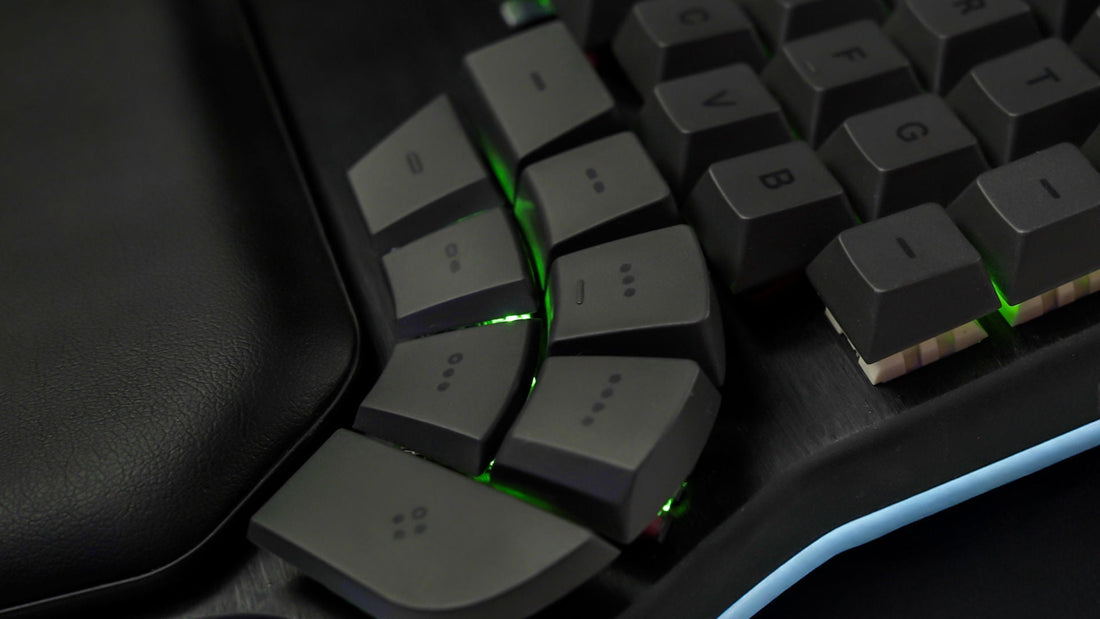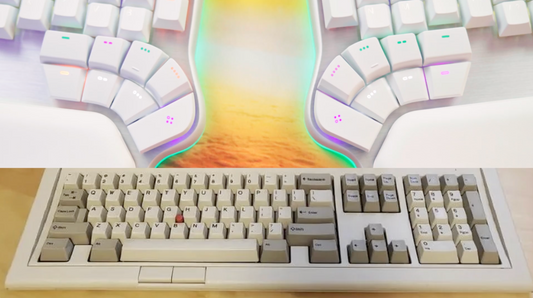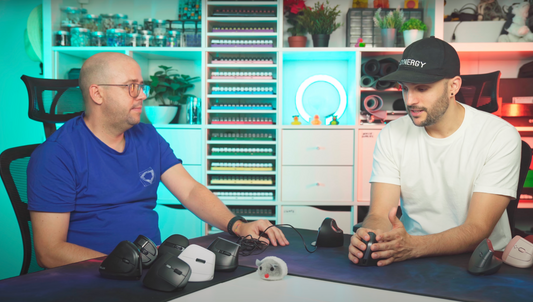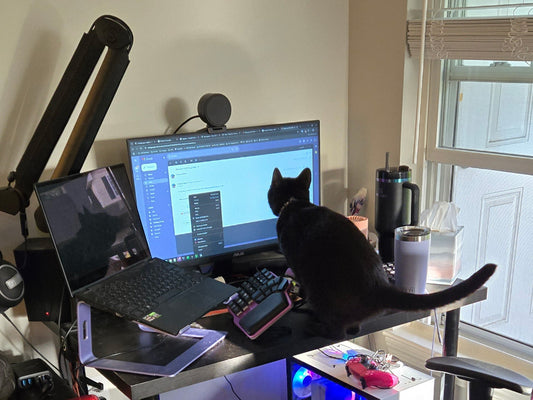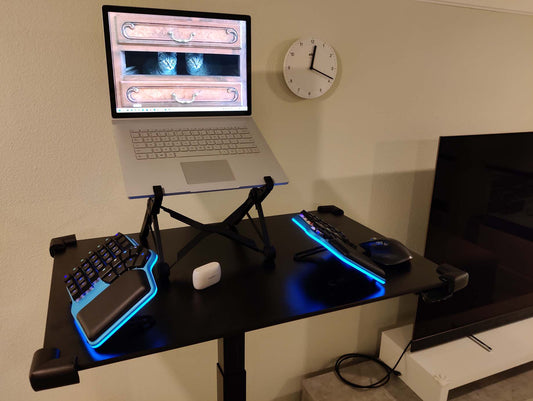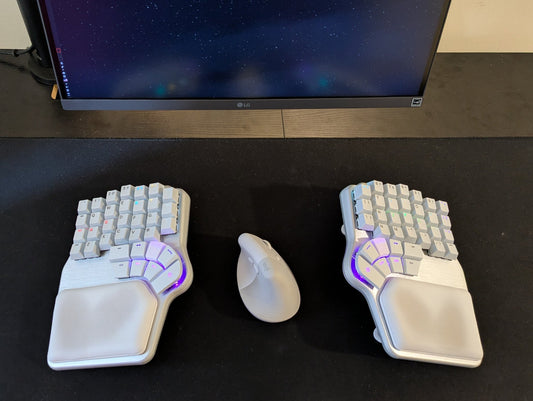Choosing the right keycaps is critical when designing a keyboard. They define not just how your keyboard looks — but how it feels to type every single word. The texture under your fingertips, the sound of every press, and even the keyboard’s long-term durability depend on these tiny pieces of plastic.
However, when it comes to keycaps, there’s an overwhelming amount of acronyms and terms: ABS, PBT, PC, Laser-Etched, Double-Shot, Pad-Print… and more. These refer to how a keycap is made — and it matters a lot.
The material and manufacturing technique directly affect appearance, feel, sound, cost, and durability. If you want a keyboard that feels premium, lasts years, and sounds right for your setup, it’s essential to understand the differences between each type.
Keycap Materials
Although keycaps can technically be made of rubber, metal, ceramic, or even wood, most modern keycaps are made of plastic — typically ABS, PC, or PBT.
ABS (Acrylonitrile Butadiene Styrene)

ABS keycaps are smooth, easy to mold, easy to paint, and naturally translucent, making them perfect for keyboards with RGB lighting. They can be made in any color, allowing for vibrant, sharp legends.

ABS often gets a bad reputation because it’s used in cheap keyboards, but you’ll also find it in premium keycap sets costing over $200. The key difference is in the manufacturing method, not the material itself.

PC (Polycarbonate)

PC keycaps are less common but very strong. PC is similar to ABS, yet clearer, tougher, and slightly more flexible. It’s great for translucent legends and crisp RGB diffusion. However, it’s more expensive and a bit trickier to manufacture, which limits its use.

PBT (Polybutylene Terephthalate)

PBT keycaps are harder and more heat-resistant. They have a slightly rough, matte texture that resists shine — one of the reasons keyboard enthusiasts love PBT. These keycaps keep their texture and appearance almost forever.
On the downside, PBT is harder to manufacture. Its colors aren’t as bright as ABS, and the material is opaque, which means light can’t pass through the legends — something important for RGB backlighting.

So, those are the materials — but that’s only half the story. The real magic lies in how the legends (the characters on each key) are created.
Keycap Manufacturing Methods
Each manufacturing technique directly impacts durability, legend sharpness, RGB shine-through, and overall feel. Let’s explore the main ones used in mechanical keyboards today.
Pad Printing

Pad printing is one of the most traditional and affordable keycap manufacturing methods. A silicone pad transfers ink from an engraved metal plate to the surface of the keycap.

This technique is cheap, fast, and flexible. You can use a simple plastic injection mold (often opaque ABS) and add any desired legend on top. Pad printing also allows for light legends on dark keycaps.
However, there are drawbacks. The keycaps are opaque (no RGB light passes through), the legends don’t look as crisp — they feel more like decals — and most importantly, they wear off easily.

Therefore, pad-printed keycaps are mostly found on budget office keyboards and laptops. Still, some higher-end devices like the Logitech Ergo K860 also use them.
UV Printing

A more modern method is UV printing. This process sprays ink directly onto the keycap and then cures it instantly with ultraviolet light.
It’s an extremely fast and flexible technique that allows for full-color graphics.

However, because the ink sits on top of the surface, it can wear off over time with heavy use, and the keycaps remain opaque — meaning no light passes through.

For users who want illuminated legends, there’s a better option: laser etching.
Laser Etching

Laser etching starts with a transparent ABS or PC keycap made via standard plastic injection molding. The keycap is then painted with the desired surface color, and a laser removes the paint where the legend should be, revealing the transparent plastic underneath.

This allows RGB light to shine through the legends, making it a popular choice for illuminated keyboards. It’s flexible and relatively simple, as you can etch any legend using the same mold.

Over time, however, depending on the coating quality, the surface paint can become shiny or even wear off. That’s why more durable alternatives exist, like double-shot keycaps.

Double-Shot

In the double-shot process, two separate plastic injections form the keycap: one for the legend and one for the body. This is also known as double injection molding.

If translucent ABS is used for the legend, light shines perfectly through it — creating that distinctive “shine-through” effect. Because the legend and body are two different layers of plastic, the legend will never fade or wear off.

Most double-shot keycaps are made from PBT for its superior texture, though ABS is also used when vibrant colors are desired. Not all double-shot keycaps are created equal: wall thickness, mold quality, and legend alignment all affect the final result.

If you look closely at some shine-through keycaps, you might notice small supports inside letters like “O” or “D.” These are part of the internal structure from the double-shot process.

While this method provides unmatched quality, it’s also the most expensive. It requires two molds for every keycap, and the same mold cannot be reused for different legends. Producing localized versions (for different languages) means creating a full new set of molds, which can cost well over $100,000.
Dye-Sublimation (Dye-Sub)

Dye-sublimation is another popular way to create durable legends, especially on PBT keycaps. The process starts with special sublimation paper printed with pigment. This paper is placed over the blank keycap, and heat is applied to transfer the dye into the keycap’s surface.

The pigment penetrates the plastic itself, similar to the process used for high-quality printed T-shirts. The result is a long-lasting legend that won’t wear off because it’s literally part of the material.

Dye-sublimation is easier to manufacture and doesn’t require separate molds, which allows for easy customization and multilingual layouts. However, it has two limitations: the keycaps are fully opaque (no light passes through), and the legends must be darker than the keycap color. To achieve light legends on dark caps, manufacturers must use reverse dye-sublimation, a trickier process that dyes the entire keycap instead of just the legend.

Other Manufacturing Methods
While less common, there are also other manufacturing techniques like engraving, CNC milling (used for metal or wood keycaps), triple-shot molding (for multi-color designs), and water transfer printing (for custom textures or patterns). These are typically reserved for specialty or limited-edition keyboards.

What Keycaps Does Dygma Use?
When deciding which keycaps to use on our keyboards — the Dygma Raise 2 and Dygma Defy, we faced a classic design dilemma.
On one hand, we wanted the nicest feeling and most durable keycaps possible — ideally double-shot PBT keycaps. On the other hand, we needed sharp shine-through legends and multilingual options, something that’s only viable with laser-etched keycaps due to the high cost of producing molds for each language.
For the Dygma Raise and Raise 2, which feature a more standard staggered layout, we partnered with a supplier offering high-quality PBT double-shot keycaps and even developed a small double-shot mold for our custom thumbkeys.

However, those keycaps were available only in English. We used laser-etched keycaps for other languages such as Spanish, German, Nordic, or Dash layouts. Over time, we improved these keycaps by adding a textured coating and switching from ABS to polycarbonate for greater durability.
The challenge was even greater for the Dygma Defy. Unlike standard keyboards, the Defy includes extra 1U keycaps in its outer and inner columns. We couldn’t find a double-shot PBT set that included those keys with suitable legends — nobody wants a “NumPad 7” instead of a “Tab.”

Creating our own molds wasn’t feasible for a niche ergonomic keyboard: it’s extremely expensive (over $100k) and time-consuming. So, we opted for polycarbonate laser-etched keycaps, achieving the best balance between quality, versatility, and cost.
New Sub-Dye Dygma Keycaps
That said, a high-end keyboard deserves high-end PBT keycaps. This has been one of the most common requests from our community — and we fully agree. We’re proud to announce our new Sub-Dye PBT keycaps for the Dygma Defy.

These new keycaps are available in dark grey with black legends and white with grey legends. It’s a limited-run production of just 300 sets, designed to gather community feedback and make final refinements before future runs.

Even though these keycaps don’t have shine-through legends, many users might actually prefer them. They’re thicker, heavier, and feel more premium. A standard double-shot keycap has a 1.1 mm wall and weighs around 1.25 g, while these Sub-Dye PBT keycaps have a 1.8 mm wall and weigh 1.65 g — resulting in a deeper, more satisfying sound profile and an overall more solid typing experience.

This project wasn’t easy. We had to create a special mold for the thumb cluster — the polycarbonate mold made the surface too smooth — and perfecting the legends’ color and alignment took countless samples and adjustments.

We believe it’s been entirely worth it. The new Sub-Dye PBT keycaps look fantastic and feel incredible on the Dygma Defy. They combine the durability and texture of PBT with the refined look that our users expect from a high-end ergonomic keyboard.
We can’t wait to hear your feedback — and if you like them, we may release new limited-run editions in other colors or even versions for the Raise 2.

Let us know what you think, and don’t forget to subscribe to our newsletter to stay updated on future releases and keyboard design insights.
